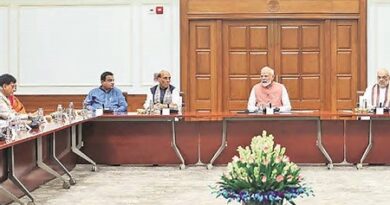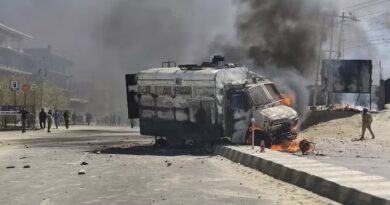China border dispute tops India’s security challenges: CDS Chauhan
Defense chief identifies six major threats at Gorakhpur seminar, emphasizes nuclear dimension and evolving warfare
NewsArc Bureau
Gorakhpur, September 5, 2025 – India’s Chief of Defence Staff General Anil Chauhan has identified the prolonged border dispute with China as the nation’s paramount security challenge, warning that the unresolved territorial issues continue to pose the greatest threat to national stability. Speaking at a high-profile seminar on national security at Gorakhnath Temple, Chauhan outlined a comprehensive threat assessment that underscores India’s complex strategic environment.
Six-Point Security Framework
Primary Challenge: China Border Dispute
General Chauhan emphasized that the boundary disagreement with China represents India’s most significant long-term security concern. “The boundary dispute with China is India’s biggest challenge and will continue to remain so,” he stated, noting how these tensions have historically manifested in conflicts including the 1962 war and continue to influence regional stability.
The assessment reflects the ongoing nature of Indo-China border management, with recent incidents in Ladakh and Arunachal Pradesh highlighting the persistent nature of territorial disagreements that have remained unresolved since India’s independence.
Pakistan’s Proxy War Strategy
The second major threat identified was Pakistan’s sustained campaign of proxy warfare, characterized by what Chauhan described as a deliberate strategy to “bleed India by a thousand cuts.” This approach involves systematic use of terrorism and cross-border infiltration designed to destabilize India through sustained low-intensity conflict.
The CDS specifically referenced Pakistan’s policy of “keeping hurting India slowly at regular intervals,” highlighting the calculated nature of this security challenge that has persisted for decades.
Regional Instability Impact
Chauhan identified widespread instability among neighboring nations as the third critical challenge. The social, political, and economic turbulence across South Asia creates a volatile security environment that directly impacts India’s strategic calculations and border management requirements.
Evolution of Warfare Domains
The fourth challenge encompasses the rapidly changing nature of modern warfare, particularly the emergence of cyber, space, and electromagnetic domains as critical battlefields. This transformation requires India to develop capabilities beyond traditional military platforms to address threats across multiple technological frontiers.
Nuclear Dimension Complexity
The fifth challenge specifically addresses the complications arising from having two nuclear-armed adversaries. “Both our adversaries are nuclear powers, making it a challenge to decide what kind of operations we undertake,” Chauhan noted, highlighting how nuclear capabilities constrain conventional military options and require careful strategic calibration.
Technological Advancement Imperative
The sixth challenge involves keeping pace with rapid military technological evolution, including robotics and artificial intelligence applications in defense. Chauhan emphasized the need for enhanced self-reliance in defense research and potentially establishing a National Defence University to address these requirements.
Operation Sindoor: Strategic Response
General Chauhan provided insights into Operation Sindoor, launched in May 2025 following the April 22 Pahalgam terror attack. The operation targeted nine terror camps across Pakistan and Pakistan-occupied Kashmir, representing a multi-domain response involving cyber warfare capabilities and coordinated tri-services operations.
“The operation’s goal was not mere retaliation but to draw a red line on cross-border terrorism,” Chauhan explained, indicating a strategic shift toward establishing clear deterrent boundaries rather than purely reactive measures.
The operation, which has not been officially terminated, demonstrates India’s enhanced precision strike capabilities developed since the 2019 Balakot airstrikes, while Pakistan has focused primarily on strengthening air defense systems in response.
Political Perspective: CM Yogi’s Assessment
Uttar Pradesh Chief Minister Yogi Adityanath, sharing the platform, offered a stark assessment of regional dynamics. Drawing from Chanakya’s strategic philosophy, he predicted Pakistan’s potential collapse, stating: “Pakistan is completely hollowed out and will soon cease to exist.”
Adityanath contrasted India’s stability with Pakistan’s internal chaos, emphasizing India’s approach of treating the nation as a “mother” that requires protection from external threats. He invoked historical references to Lord Rama and Krishna to underscore the philosophical basis for eliminating security threats.
Defense Investment and Capabilities
India’s commitment to addressing these challenges is reflected in its 2025 defense budget of $81 billion, representing a 10% increase from the previous year. This investment targets enhanced capabilities across the domains identified by the CDS, including cyber warfare, space-based assets, and advanced military technology.
Strategic Initiatives
Sudarshan Chakra Mission
Chauhan highlighted the Sudarshan Chakra Mission as a comprehensive multi-defense initiative designed to counter various attack vectors. This program aligns with India’s broader strategic vision of achieving developed nation status by 2047 while maintaining robust defense capabilities.
Cultural and Historical Context
The seminar, held on the death anniversary of Mahant Digvijaynath Maharaj and Mahant Avaidyanath Maharaj, underscored the cultural dimensions of national security discourse. Chauhan’s participation in the Gorakha War Memorial renovation ceremony and visits to Gorakhnath Temple highlighted the integration of cultural heritage with contemporary security planning.
Strategic Implications
The CDS’s comprehensive threat assessment signals several key strategic directions:
Multi-Domain Preparedness: Recognition that future conflicts will span traditional military, cyber, space, and electromagnetic domains requires integrated defense planning and capability development.
Nuclear Constraint Management: The presence of two nuclear-armed adversaries necessitates sophisticated strategic planning that balances deterrence with escalation control.
Self-Reliance Emphasis: The push for indigenous defense capabilities reflects lessons from global supply chain vulnerabilities and the need for strategic autonomy.
Preemptive Approach: Operations like Sindoor indicate a shift from reactive to proactive security postures, establishing clear deterrent signals.




